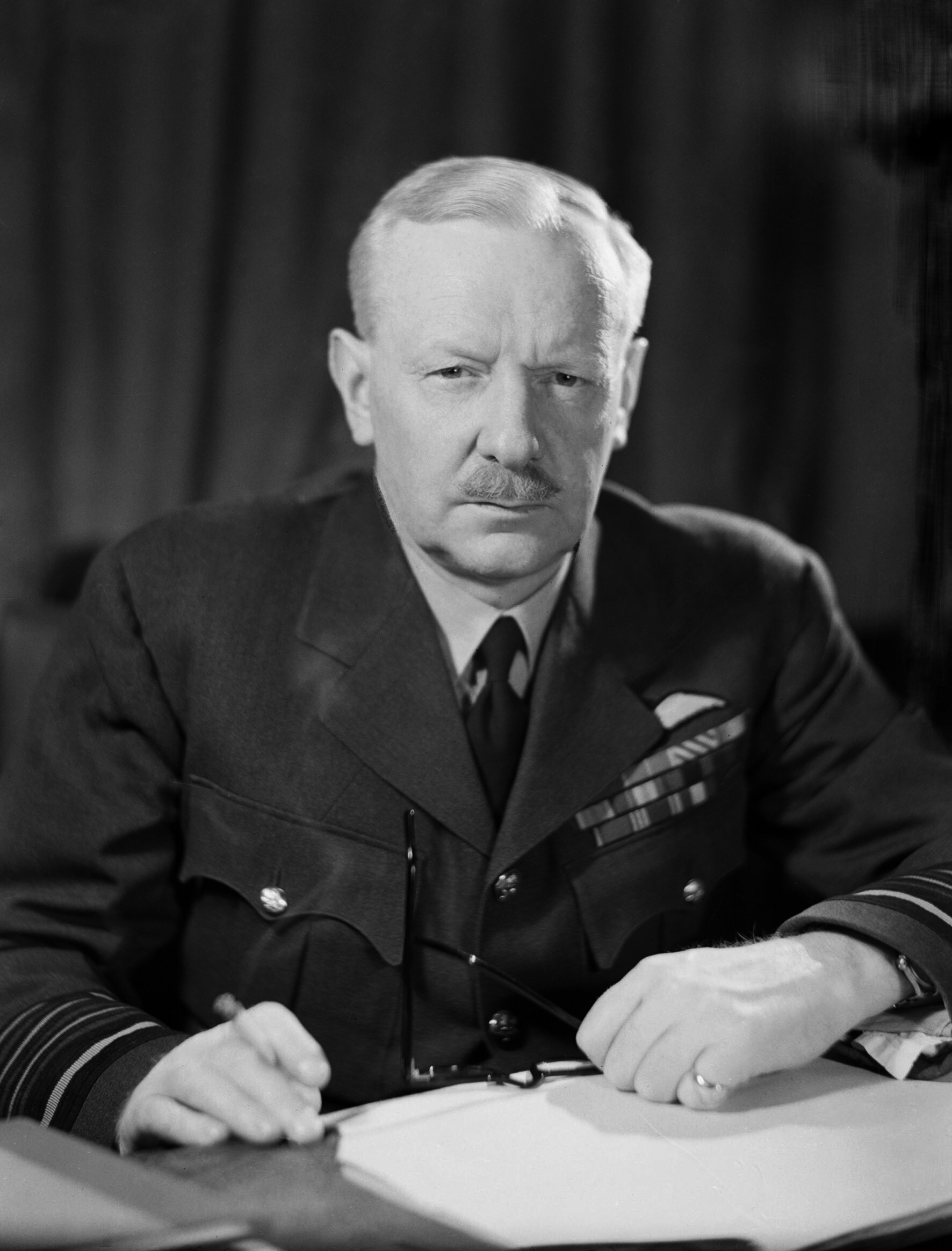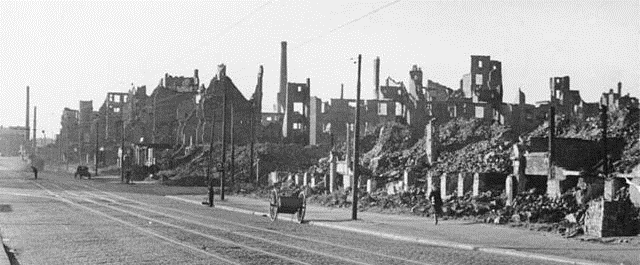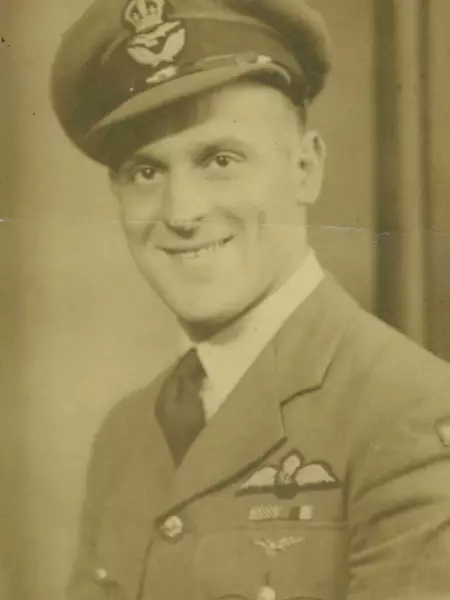Operations
Operations
The Battle of Hamburg 1943

Air Chief Marshal Sir Arthur Harris
(Credit: Imperial War Museum)
The Battle of the Ruhr earlier in 1943 had given an impressive demonstration of the growing power of Bomber Command. Not only had a hitherto invulnerable industrial area been severely damaged for the first time, but Bomber Command leadership saw no reason to believe why this success could not be repeated elsewhere on targets within Oboe range. No longer was success dependent on weather and indeed luck.
Air Marshall Harris regarded the Ruhr as only the beginning of a serious bomber offensive. After the five-month long attack on the Germain industrial centre, Bomber Command’s attention turned to Hamburg. While much shorter in duration, Operation Gomorrah was a campaign of extraordinary intensity and an important event in the moral argument of Bomber Command operations. As Harris himself said, in his operational order on the eve of the attack ‘The total destruction of this city, would achieve immeasurable results in reducing the industrial capacity of the enemy’s war machine.’
Beginning on 24 July 1943 and lasting for eight days and seven nights, with coordinated nighttime attacks by the RAF and daylight raids by the USAAF Eighth Air Force. Over the course of seven days, ten thousand tons of bombs were dropped on Hamburg, military industrial capacity severely weakened, and an estimated 40,000 German civilians killed.
Why Hamburg?
Germany’s second largest city appealed as a target to Allied planners for several reasons. Hamburg contained more industrial targets of interest to the Ministry of Economic Warfare than most other German cities. These included aircraft factories and oil installations. The city’s shipbuilding industry made it a priority target, in particular the Blohm and Voss shipyards which built the U-Boats so damaging to Britain’s vital supply chain across the Atlantic.
Operationally, Hamburg was an attractive target as it was reasonably close to the bomber bases in Britain, with flight plans largely over the North Sea, with less exposure to anti-aircraft fire and fighters than other cities. Located on the river Elbe and near the coast, it was a relatively easy target to locate.

The First Night
Planning to strike this city of industry, Harris ordered a 10-day-long campaign targeting the city, code-naming it Operation Gomorrah, a reference to the biblical rain of ruin and fire coming from above.
Originally planned for July 22, the first raid was delayed for two days due to cloud coverage; by the 24th, the skies had cleared. That evening, starting at approximately 10:00 p.m., 791 British bombers took off under cover of darkness. The air fleet was composed of Lancaster, Stirling, Wellington, and Halifax bombers flying in six waves. Each wave had between 100 to 120 aircraft hoping to concentrate as much destruction as possible.
Between 1:00 a.m. and 2:00 a.m., 2,300 tons of bombs were dropped on the city, at the time the most in a single operation. Included in the aerial salvo were 8,000-pound “block busters” and 4,000-pound “cookies,” along with over 350,000 individual incendiary bombs. It was these incendiary bombs that caused much of the havoc.
Hamburg had been considered particularly susceptible to attack with incendiaries, which, from the experience of the Blitz, were felt to inflict more damage than just high explosive bombs. And so, it proved.
Good flying conditions ensured that the bombing was highly concentrated around the intended targets. The resulting conflagration created a vortex and whirling updraft of super-heated air which became a tornado of fire. Most of the destruction that night was not from the explosions, but the ensuing fires.
As the RAF bombers cleared the area and returned home, the planners discovered that this first raid cost them a ‘mere’ 12 planes.
Just the Beginning.
The next afternoon, 123 American B-17 “Flying Fortress” bombers arrived over the city. The American approach to strategic bombing was much different from the British. The US Army Air Forces (USAAF) professed a doctrine of daylight precision that looked to avoid area bombardment and strike only designated military and strategic targets.
The Americans targeted the city’s shipyards and the Klockner aircraft engine factory. Of the 109 aircraft that reached Hamburg, 15 failed to return, a 12 percent loss rate. Such numbers would become an unfortunate standard for the Eighth Air Force in the autumn of 1943.
This raid was followed by two further American daylight raids. Yet while the city had endured three consecutive days of bombing, the worst was yet to come.
Tuesday 27 July was another hot day in an already long summer and the city was tinder dry. Emergency teams were busy dealing with fires from earlier raids in the western districts.
At 10:00 p.m. on July 27, Bomber Command launched 787 bombers, with pathfinders dropping marker flares just after midnight. The bomber stream began dropping incendiaries at 1:00 a.m., and bombs continued to fall for the next 45 minutes.
With bombs falling largely in the eastern part of the city, fires began to rage. An RAF pilot later recalled: “We didn’t need any navigation. We could see Hamburg from over the North Sea. … With the coloured flares and flames … this was particularly awful.” With this cauldron of fire observed from above, the scene below in the city became something unimaginable.
In the next few hours, a new word was added to the dictionary of war – firestorm (feuersturm). Concentrated, unchecked fires linked up to turn parts of Hamburg into a furnace. Hot air soared into the sky, sucking more from street level.
Winds reached speeds of up to 240km/h and temperatures reached at least 800C. Apartment blocks became shells within minutes. Streets became tunnels of screaming hurricane-force winds – one survivor recalled a noise “like an old church organ when someone is playing all the notes at once”.
At 1:47 a.m., the last bomber dropped its load as the firestorm was already building. A sea of flame grew with temperatures quickly rising over 1,000 degrees Celsius. Superheated air rose above the flames, creating a vacuum that sucked in more air and oxygen, thus feeding the rapidly growing inferno.
The fire seemed to become a living entity, changing course at will, consuming everything in its path, and generating a heat that melted glass and cutlery and turned bricks to ash.
For hours, the city burned. While no definitive casualty number was recorded, most estimates of this one raid place it near 20,000. Many of the deaths were not caused by fire, but from smoke inhalation or carbon monoxide poisoning as the flames consumed all the available oxygen.
Once again bomber casualties were relatively light, with much of the fighter defences diverted elsewhere.
The Assault Continues
The firestorm was not an isolated incident. Scenes were reported again two days later on July 29–30, when 777 RAF planes headed for the city. During this raid, Luftwaffe defences responded in force, knocking down over 30 British aircraft.
Despite these German aerial victories, the bulk of the bombers still arrived over the city. Just after midnight, they dropped their ordnance for 45 minutes over a much wider area than before.
Despite the rather scattershot pattern, a second firestorm occurred, but this time in the northern sections of Hamburg. While many inhabitants had fled the city after the earlier raids, a substantial number remained Estimates made later reported approximately 1,000 deaths that night, along with most of the suburban landscape being torched.
While it seemed there was not much left to bomb in the city, the RAF conducted a fourth raid on August 2–3, but this time the bombers were met with bad weather and many were forced to scatter across northern Germany, sparing the city from the most severe damage.
Operation Gomorrah ran until 3 August 1943 and involved six major raids. Estimates of the dead vary between 34,000 and 43,000. Somewhere upwards of half of all homes in the city were destroyed. A million of the 1.7m population fled.
Records show the destruction of 580 industrial plants 2,632 businesses, 379 office buildings, 24 hospitals, 277 schools and 257 government or Nazi party buildings.
What did Operation Gomorrah Achieve?
For all the cost, what was the effect on Nazi Germany’s war effort? It is reported that news of the attacks ran like wildfire. Fear and panic filled other cities that saw themselves next on the ‘hit list’.
These fears were felt at the top of Nazi leadership. The ferocity and violence displayed led German Armaments Minister Albert Speer to write, “Hamburg … put the fear of god in me.” Speer went on to predict “a series of attacks of this sort, extended six months or more, would bring German armaments production to a halt.” While Nazi propaganda minister Joseph Goebbels wrote in his diary about the ‘Sword of Damocles hovering over Germany.’
Despite Speer’s prediction, Hamburg’s recuperative powers were remarkable. Within five months, the city was back at 80 percent of its pre-bombing production. Despite this apparent recovery, demoralisation and destruction remained a long-term problem that certainly weakened war production in many arms factories and refineries even when operational again.
Importantly, demands to protect the home front had a practical impact, in diverting arms from the battlefields, both the Eastern front and defences in France to resist a future Allied invasion. They had a psychological impact too, by raising questions on the fronts about was happening to loved ones at home.
While Hamburg was never hit again with such force, other German cities were now in the crosshairs of the Allies. In the next few years, others would meet a similar fate.

New Zealanders who flew to Hamburg
Sixteen New Zealanders were killed during Operation Gomorrah, with several more captured after parachuting.
Among the casualties was Jim Mosen, a Lancaster pilot on 115 Sq. Mosen’s crew had flown their first mission on the opening night of Operation Gomorrah (july24-25). They then flew to Essen the next night before Hamburg again on July 29-30. They were targeting Hamburg once again on the final night, Aug 2-3 when their Lancaster was struck by lightning and exploded. Mosen and fellow Kiwi, bomb aimer Len Talbot are interred in the Hamburg War Cemetery.
Trevor Dill of 75 (NZ) Squadron recalled that night “A great thunderstorm over the whole area. We got so iced up that we lost all our air speed and ice was smacking off the propellers into the fuselage … lightning everywhere … streaming off the guns, and the propellers were rings of light… we had to get down out of the ice and came right down low into pouring rain…. A bit dicey when you are flying around through searchlights, and you get on the point of stall and start shuddering and have to bring your nose down”.
The New Zealand Squadron took part in each of the four major attacks on Hamburg, despatching a total of seventy-nine sorties. This was in addition to the attacks on Essen and Remscheid during the last weeks of July which marked the final stage of the Ruhr battle.
75’s Wing Commander Wyatt declared “It has been a terrific week for everybody – for ground crews as well as for the flying men. The fitters, mechanics and the riggers have worked without stint to get the bombers ready for the next operation. As a result, we have put up more aircraft in the last week than ever before.”
On the first three raids on Hamburg 75 Sq. was fortunate, all but one of the Stirlings returning safely. In the last attack, however, two of the seventeen bombers which took off on that eventful August night failed to return. One was shot down over Germany and the other crashed into the North Sea. All members of both crews were lost.
One New Zealander with 115 Sq., whose squadron motto appropriately enough was ‘Despite the Elements’, told how his bomber finally reached the vicinity of Hamburg that night after flying through cloud, rain and electrical storms on the final Hamburg mission. ‘The clouds were very dense and miles high and so thick that we had to come down very low before getting under them. A violent thunderstorm was raging, and brilliant flashes of lightning lit up the ground. Suddenly we saw the twisting outline of the river Elbe and were then able to fix our position.’
Another crew reported that they flew over the target area six times before they could find a way through the cloud.
Jim Insull, a navigator with 218 Sq., on his first mission described Hamburg as “a shapeless mass of fire that it all appeared like a badly focused technicoloured film of lights that seemed to move, twinkle and shimmer in a thousand shapes in colours of red, yellow and orange on a background of black velvet”.
Nick Matich (35 Sq. PFF), who survived almost fifty operations and earned both the DSO and DSM was an unusual casualty of Gomorrah, crashing on take-off on the first of the Hamburg missions. One engine of his Halifax failed on take-off and Matich managed to bring the aircraft to a halt. As they taxied back the motor picked up and the crew agreed to try again. This time both outer engines failed, and the Halifax speared through the outer fence and into a field, The crew managed to escape unhurt.
Another New Zealander who had a very eventful flight was Pilot Officer Elder of No. 76 Squadron who brought back a crippled Halifax with one member of his crew dead and two wounded after one of the raids. German fighters had attacked the Halifax shortly after the bomb load was released, killing the mid-upper gunner, and putting the port engine out of action.
While the gunners fought off the fighters, the bomb aimer took an axe and cut away burning pieces of the fuselage. On reaching the first lighted airfield in England after a difficult flight, Elder ordered the unwounded members of his crew to bail out because he feared a dangerous crash-landing.
The navigator, bomb aimer, and wireless operator all left the aircraft and came down safely. After strapping the badly injured rear gunner in the rest position the engineer, who had himself been wounded in the legs, helped Elder to bring the bomber down on the grass outside the runway.
The Halifax skidded along to the end of the airfield, jumped a ditch, went through a fence, and finished up by tearing the port engines out on some tree stumps before it finally came to rest, those still onboard surviving the landing.

Fl Lt. Nicholas Matich DSO DSM (Credit: Online Cenotaph)